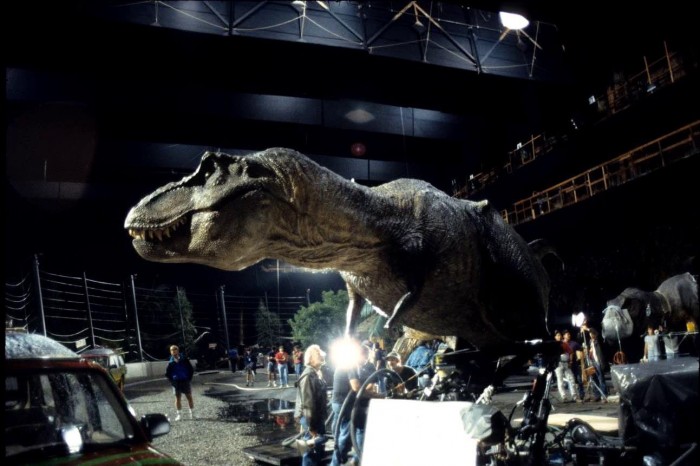Original T. Rex Returns In 'Jurassic World,' This Film "Is Her Unforgiven"
Jurassic World has a few direct callbacks to Steven Spielberg's original Jurassic Park. There's the shell of the old visitor center, for one, with that famous banner still on the floor. And the original design for one of the first film's signature attractions was used to bring her back to life for this fourth movie.
That's right: the T. rex is back, and it's not just a Tyrannosaurus, but the Tyrannosaurus that menaced Ian Malcolm and everyone else in the original movie. She's older, maybe a little slower, but her nature hasn't changed. "This movie is her Unforgiven," said director Colin Trevorrow when we talked to him on set. Read his comments about the returning beast, as well as info about the new Jurassic World performance capture dinos, after the break.
Trevorrow was happy to talk about the return of the grand old T. rex in the new film.
You mentioned earlier that there's a dinosaur that we have seen in the previous films that we're going to get to see.
The T. rex that's in the film is the T. rex from the original Jurassic Park. She is 22 years older. But she's not limping around.
Will audiences immediately recognize that it's the same–?
I hope so. Yeah. I mean, we took the original design and obviously, technology has changed. So, it's going to move a little bit differently, but it'll move differently because it's older. And we're giving her some scars and we're tightening her skin. So, she has that feeling of, like, an older Burt Lancaster. And this movie is her Unforgiven.
Did you get to build her again?
We got to build everyone from the ground up because technology has changed so much that everything is a rebuild. And I got to bring in dinosaurs that I've always thought deserved a big scene. There's an Ankylosaurus in this movie; was a really big scene and that's just a bad ass dinosaur. And there are others. There's smaller appearances, some bigger appearances. You know, we have an underwater reptile. I'm sure you've heard about that. That thing is pretty cool. We have a new kind of flying dinosaur that no one's ever seen before, you know, in addition to the Pteranodons that are really scary. And I didn't want to just throw the kitchen sink at it. Each of these movies has done a good job at just very carefully, in a measured way, increasing the new dinosaurs that you see. But, there's a lot of dinosaurs in the movie for sure.

And then there's the new approach used in this film, which perhaps emulates films like the recent Planet of the Apes movies more than it does the original Jurassic Park. While there are some animatronic elements this time, the major dinosaur presences are created with performance capture.
Can you talk a little bit about some of the practical versus CG dino creations?
A little, yeah. I mean, we have one scene that is an animatronic animal. I don't want to tell you the nature of it, but it's really beautiful and it's a real tribute to Stan Winston and what he did. And there's other elements of–it's just a very special moment. So, that's something I want people to discover. There are other elements where animatronics are used just so people can touch them. And there are other moments where maybe in the past they would've used an animatronic. They might've built, you know, a giant head but because a scene is so short or brief in which you just see the head, we've tried to, you know, keep that motion and that sense of, like, slow wait.
So, even some of the CG animals will look animatronic based on the way that they move because usually when you get really up close to the head, there was just that sense that it could crush you if you got underneath it. And it's very difficult to do with CG, but we've come so far that we always try to have it interact with something practical. Little things move. So, I think however far the animatronics take us, I think people will feel like we maybe used more than we did just because the way we're executing it.
Absolutely.
Can you talk about why you made that choice?
It's something that ILM has been developing for a while and I went up there in September last year and I was able to sit on a stage and just move somebody around a space and just understand the fundamentals of how it worked. And there were a lot of questions as to whether that process could work for the larger animals. We knew it would work for the raptors because they're at least somewhat human in height. But, when you get down to a 20 foot high, 50 foot long animal, is that going to translate? And then they tended to hone it and it really does. I'm not sure why, but the physics work and it's pretty thrilling to watch. I think living things can recognize the movement of other living things and all the best animators in the world can't quite capture that something.
